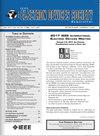Negative Activation Energy of Gate Reliability in Schottky-Gate p-GaN HEMTs: Combined Gate Leakage Current Modeling and Spectral Electroluminescence Investigation
IF 2.4
3区 工程技术
Q3 ENGINEERING, ELECTRICAL & ELECTRONIC
引用次数: 0
Abstract
For the first time, we use electrical characterization, spectrally-resolved electroluminescence measurements and degradation tests to explain the negative activation energy of gate reliability in power GaN HEMTs with p-GaN Schottky gate. First, the origin of gate leakage current was modeled. The results indicate that the gate leakage current originates from three different mechanisms: (i) thermionic emission of electrons from the uid-GaN layer across the AlGaN barrier, for gate voltages below threshold肖特基栅p-GaN HEMT中栅极可靠性的负活化能:栅极漏电流建模与光谱电致发光调查相结合
我们首次利用电气特性分析、光谱分辨电致发光测量和降解测试来解释具有 p-GaN 肖特基栅极的功率 GaN HEMT 栅极可靠性的负活化能。首先,对栅极漏电流的起源进行了建模。结果表明,栅极漏电流源于三种不同的机制:(i) 当栅极电压低于阈值 $(V_{G} \lt V_{TH})$ 时,电子从 uid-GaN 层穿过 AlGaN 势垒的热离子发射;(ii) 电子从沟道到 p-GaN 层的热离子发射 $(V_{TH} \lt V_{G} \lt 4.5 V);(iii) 在更高的栅极电压下,肖特基金属上的空穴阱辅助隧道。然后,通过分析可靠性与栅极偏压的函数关系,证明了负活化能(高温下寿命更长)。通过分析高正偏压下的电致发光光谱,高温下失效时间延长的原因是空穴注入和重组增加,从而减少了发生雪崩倍增并导致击穿的电子总数。最后,通过比较应力前后器件的电气特性和传导模型,验证了该模型。
本文章由计算机程序翻译,如有差异,请以英文原文为准。
求助全文
约1分钟内获得全文
求助全文
来源期刊

IEEE Journal of the Electron Devices Society
Biochemistry, Genetics and Molecular Biology-Biotechnology
CiteScore
5.20
自引率
4.30%
发文量
124
审稿时长
9 weeks
期刊介绍:
The IEEE Journal of the Electron Devices Society (J-EDS) is an open-access, fully electronic scientific journal publishing papers ranging from fundamental to applied research that are scientifically rigorous and relevant to electron devices. The J-EDS publishes original and significant contributions relating to the theory, modelling, design, performance, and reliability of electron and ion integrated circuit devices and interconnects, involving insulators, metals, organic materials, micro-plasmas, semiconductors, quantum-effect structures, vacuum devices, and emerging materials with applications in bioelectronics, biomedical electronics, computation, communications, displays, microelectromechanics, imaging, micro-actuators, nanodevices, optoelectronics, photovoltaics, power IC''s, and micro-sensors. Tutorial and review papers on these subjects are, also, published. And, occasionally special issues with a collection of papers on particular areas in more depth and breadth are, also, published. J-EDS publishes all papers that are judged to be technically valid and original.
 求助内容:
求助内容: 应助结果提醒方式:
应助结果提醒方式:


